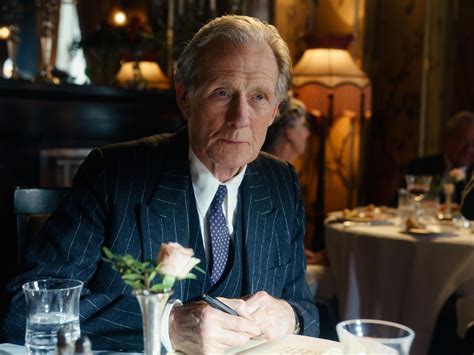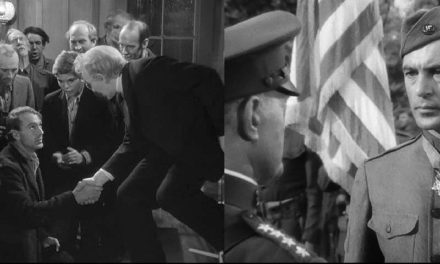Thanks to the energetic oversight of the woke thought police, cultural appropriation—once, I would have believed, flattery by imitation—has become a deadly sin. Wear the wrong costume or bring the wrong food to a party, and your name is mud. How much territory does this wet blanket of cultural-political proscription cover (or smother)? Does it go as far as blackening the reputation of a Western director for borrowing a plot from an oriental one?
If the critics’ appraisal of the film “Living” offers any clue, the answer, happily, is no. Starring Bill Nighy and directed by Oliver Hermanus, it unashamedly lifts its screenplay from Akira Kurosawa’s celebrated “Ikiru” (“To Live”) from 1952. So far, the critics seem pleased and, in some instances, delighted with the result. Even the Motion Picture Academy has smiled benignly on the result with nominations for best actor and best adapted screenplay.
The plot is simple but not simplistic. An aging civil servant (Mr. Williams or Mr. Watanabe, depending on the version of the film) has worked steadily and unspectacularly at his job for thirty years, stamping forms, either adding to the growing stacks of mothballed petitions that come to the city department he heads, or sending the residue to other departments to gather dust in their stacks. It’s a satirical picture of a bureaucratic nightmare familiar to readers of both Dickens and Kafka. When a group of distraught women arrive in the office to request that a flooded, debris-filled lot in their neighborhood be turned into a playground, the petition suffers the usual fate, traveling from department to department until it returns to its starting place to be filed among others like it. It’s a sad story, but the protagonist, a bureaucrat to the core, is hardly aware of it.
His wake-up call is a trip to his doctor who tells him he has inoperable stomach cancer and perhaps six months to live. What will he do? Insofar as he isn’t the most imaginative of men, he acts as many would: he withdraws a fairly substantial sum from his bank account and heads to the fleshpots in order, for once, to “live.” Sadly, as he admits, he doesn’t know how. And although a hack writer he meets proceeds to conduct him to the bars and strip joints, Watanabe/Williams concludes his binge as unhappy as he was when he began it, with nothing to show for the experience but a new hat.
For him, there is no going back to work—not yet—and later, as he walks the streets, he meets a young, vivacious girl who has just quit his department and needs his recommendation to get a new job. Over a few days, they have dinner, go to the movies, and innocently converse—none of which pleases his son and daughter-in-law who have an eye on the son’s inheritance.
Increasingly, the girl finds the older man’s attentions disturbing, even creepy. Is he infatuated? Not in the usual sense. What he sees in her is what he’s losing, vitality. In their final meeting as he mulls over what she has that’s about to abandon him, he suddenly recalls the women who brought the petition for the playground to his department, and, as we gather, sees that by championing its construction, he might, briefly, live. In sum, he puts himself aside for others and in that humble act finds life.
Readers of Tolstoy may recognize “The Death of Ivan Ilych” in these events; Kurosawa, a great admirer of Tolstoy and especially Dostoevsky, was himself a deft hand in the fine art of cultural appropriation. Be that as it may, “Ikiru” is, as I observed earlier, a recognized classic. But the question here is whether Hermanus’ remake is worthwhile.
In spite of the two movies’ being the same story with almost identical scripts, Hermanus makes some alterations. The length is one. “Ikiru” runs two hours and twenty-three minutes; “Living” tells the same story in one hour and forty-two minutes, a considerable act of economizing. The same thing may be said of Kurosawa’s “Seven Samurai” and “The Magnificent Seven.” But where “Seven Samurai” gains from its length in character development, I’m not sure “Irkiru” does compared to “Living.” The plight of the main character, whether Watanabe or Williams, comes across with great poignancy in both films; the general perplexity of those around him is equally clear; and his triumph through determination and humility illuminates the new version as well as the classic.
Takashi Shimura (Watanabe) and Nighy are superb; it is a role an older actor would covet, and both realize Watanabe and Williams with intelligence and sensitivity. That said, I found the supporting actors much more engaging in “Living,” especially the office workers. In “Ikiru,” Watanabe’s underlings are largely anonymous until the funeral. In contrast, Hermanus introduces them, almost in prologue, seated in a railway carriage on the way to work. We know them from the start and follow their lives, secondary though they are, at key moments in the film as they come in and out of Williams’ life.
The young woman Margaret (Aimee Lou Wood) proves a considerably more sympathetic figure than Toyo (Miki Odagiri). Margaret at least shows Williams a good deal more pity than Toyo who ultimately is disgusted with Watanabe. And Margaret’s later romantic association with Peter (Alex Sharp), one of Williams’ subordinates, ties the two plot lines together.
In these relationships, “Living” excels “Ikiru.”
In addition, cultural and religious traditions give the movies a very different feel. Watanabe’s revelation that he might accomplish something worthy through the petition for the playground comes when Toyo tells him she makes toys for children, showing him a mechanical hopping bunny. He clutches it and suddenly recalls—or so we gather—the women who wanted the park for their children. In “Living” Williams’ moment of enlightenment comes in the matching scene in conversation with Margaret. He compares life to children playing when their mother calls them inside, something they rightly dislike; nevertheless, they obey. But there is often one child, he says, who isn’t playing, who is simply waiting to be summoned. Williams states firmly that when his Maker calls him, he doesn’t want to be like that child. Both his newly discovered determination and the reference to God and children lead seamlessly to his return to the office.
The difference may seem slight, but it’s far from it. Williams spends his last few days in service to others so that he can make a better account of his life to God. Watanabe performs the same service largely because life, as the song he sings says, is brief, and one must make the best of the time one has. It is an eastern versus western mentality.
Also, the funeral party in “Ikiru” feels a bit drawn out. It is revelatory, for sure, but it gives substance to characters that Hermanus has managed to define earlier in his film with a lot less fuss. Moreover, the drunken vows of the surviving bureaucrats to live up to Watanabe’s example are manifestly hollow; in “Living” the vows are made by sober men, making their later failure even more tragic and human.
As for Kurosawa’s superiority over Hermanus, “Ikiru” remains a classic due in part to the way he tells his story without excessive sentiment. Hermanus does well enough in that department, but I could have done without Vaughan Williams’ “Fantasia on a Theme by Thomas Tallis” during Williams’ dying moments on the swing. It’s a fine piece of music, but the scene is eloquent enough without it; adding it is pure overkill.
There’s no doubt that “Ikiru” will retain its place as a cinematic masterpiece in a way that “Living” cannot. Allowing for the Tolstoian echoes, it’s a bona fide original and a great one at that. But “Living” compares well as its own distinguished effort; over time, it may and should secure its own place and not merely through reference to Kurosawa. After all, originality isn’t everything.














